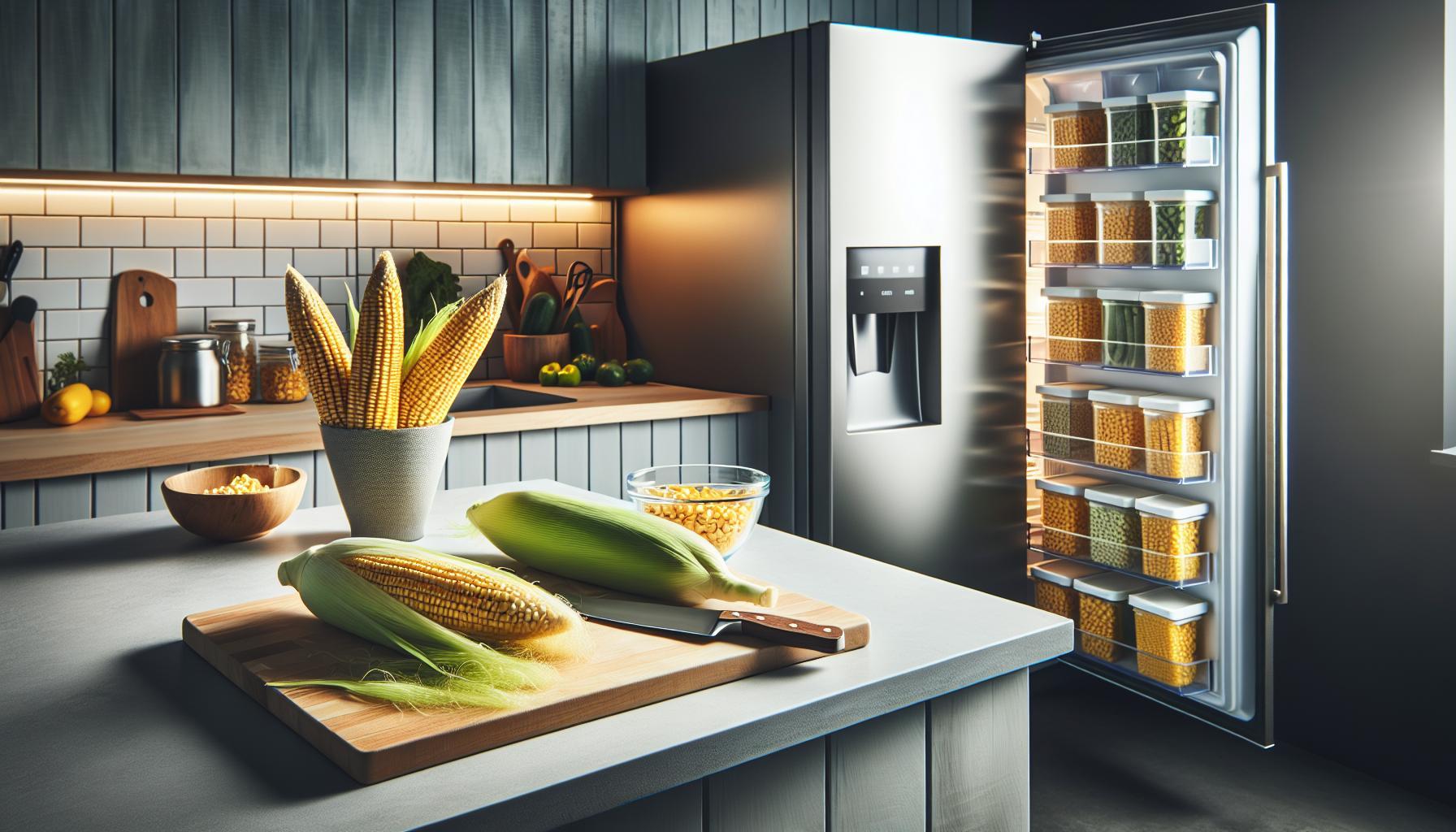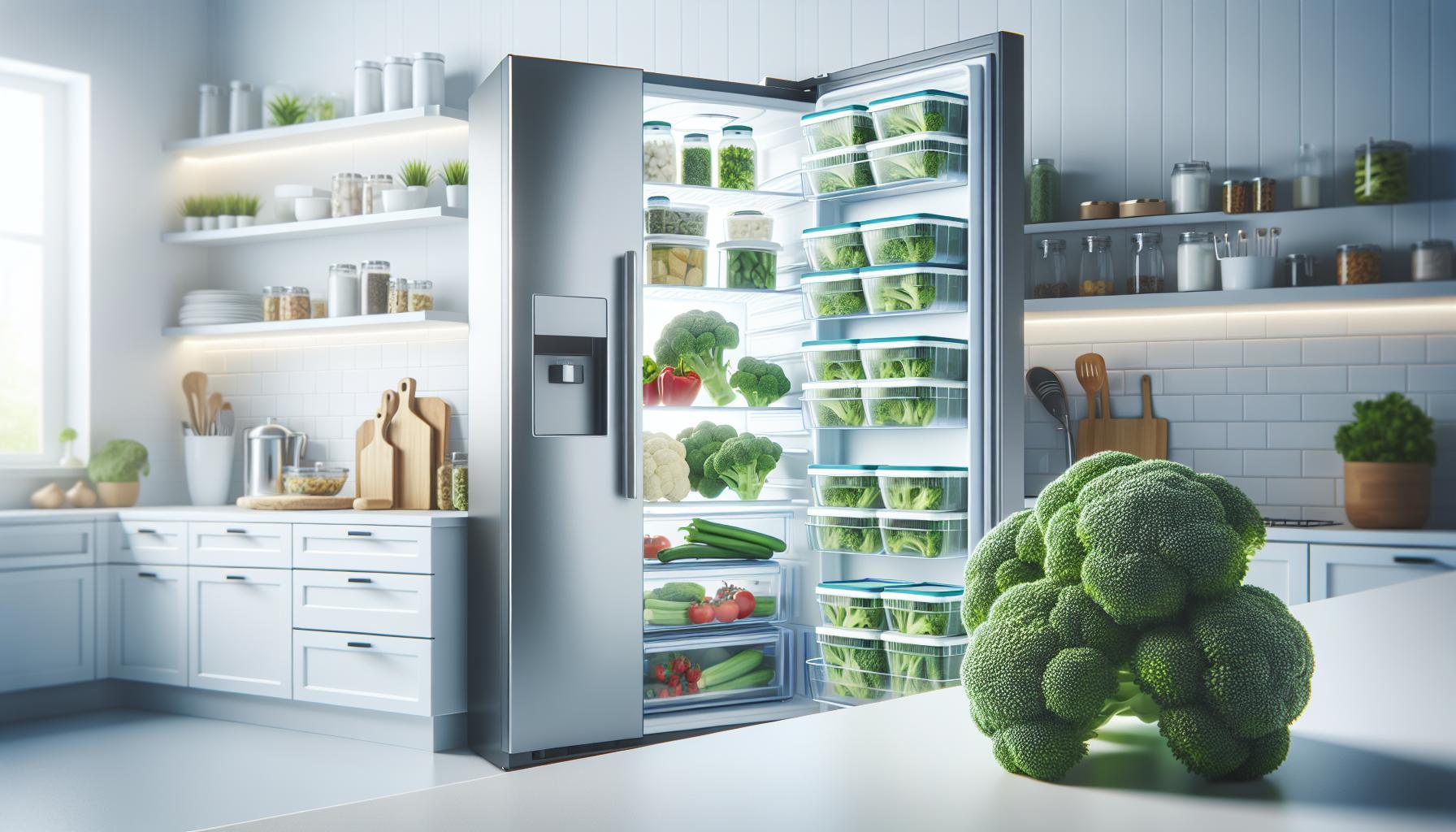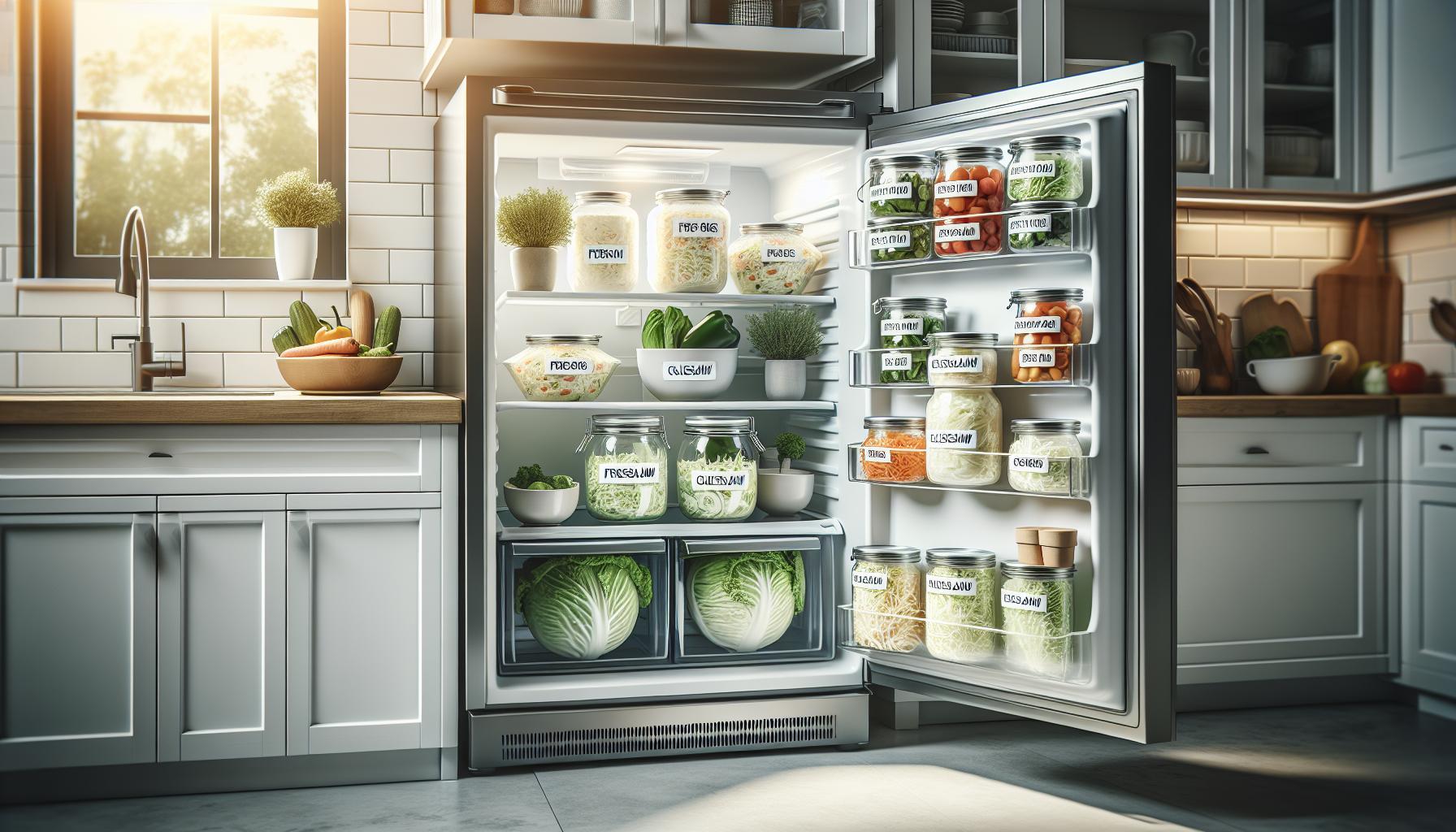Fresh corn is a summer favorite, but its sweetness diminishes quickly after harvest. Knowing how long fresh corn lasts in the fridge is crucial for maximizing flavor and ensuring food safety. Stored properly, fresh corn can remain crisp and tasty for several days, but mishandling can lead to spoilage, impacting both quality and safety.
Understanding the optimal storage conditions will not only extend the life of your corn but will also help you enjoy that crunchy texture and sweet taste longer. Whether you’re preparing for a family barbecue or simply trying to make the most of your farmers’ market haul, this guide will provide you with essential tips to keep your corn fresh. Dive in to discover the best practices for storing fresh corn and learn how to savor every bite!
How Fresh Corn is Best Stored in the Fridge
Fresh corn is a summer delight, but its sweetness and tenderness can diminish rapidly if not stored properly. To maintain the freshness and flavor of this seasonal treat, the way you store it in the fridge is crucial. Ideally, fresh corn should be kept in its husk until you are ready to use it. The husk helps to protect the kernels, retaining moisture and preventing them from drying out.
To store fresh corn in the fridge, place the ears in a perforated plastic bag, which allows for air circulation while reducing moisture loss. This simple method can help keep the corn crisp for about 1 to 3 days. If you have already shucked the corn, wrap the kernels in a damp paper towel and place them in an airtight container to prevent them from drying out. Be mindful of storing corn away from ethylene-producing fruits like apples and bananas, which can spoil the corn more quickly.
Furthermore, the fridge temperature matters. Set your refrigerator to around 32°F (0°C)-a temperature that retains the corn’s flavor without freezing it. For optimal freshness, consume the corn within a week of purchase, as it begins to lose its natural sugars just a few days after harvest, affecting both taste and texture. By following these storage techniques, you can ensure that your fresh corn remains sweet and delicious for as long as possible.
The Lifespan of Fresh Corn: What to Expect
Fresh corn is a delicious seasonal vegetable known for its sweet flavor and tender texture, but its freshness can be fleeting. When stored correctly in the refrigerator, fresh corn can maintain its optimal taste and quality for a limited time. The key to understanding the lifespan of fresh corn lies in recognizing how quickly it can lose its natural sugars once harvested. Typically, fresh corn is best consumed within 1 to 2 days of purchase to enjoy its peak flavor, but with proper care, it can stay crisp in the fridge for up to a week.
As soon as corn is harvested, the sugars stored in the kernels begin to convert to starch, which affects both its sweetness and tenderness. After about two days at room temperature, this transformation accelerates. To best preserve its quality, store fresh corn in the husk until you are ready to use it. This protective outer layer helps retain moisture and shields the kernels from air exposure, slowing down the deterioration process. If you have shucked the corn, it’s wise to wrap it in a damp paper towel and place it in an airtight container to create a mini-humidity environment, further extending its lifespan.
Intelligent storage practices can also mitigate spoilage, especially if you avoid storing corn near ethylene-producing fruits, like apples and bananas, which can hasten the spoilage process. By maintaining an appropriate temperature in the fridge-ideally around 32°F (0°C)-you can ensure the corn remains fresh without freezing. Following these techniques can help you enjoy your fresh corn at its best for as long as possible, making your culinary experiences all the more delightful.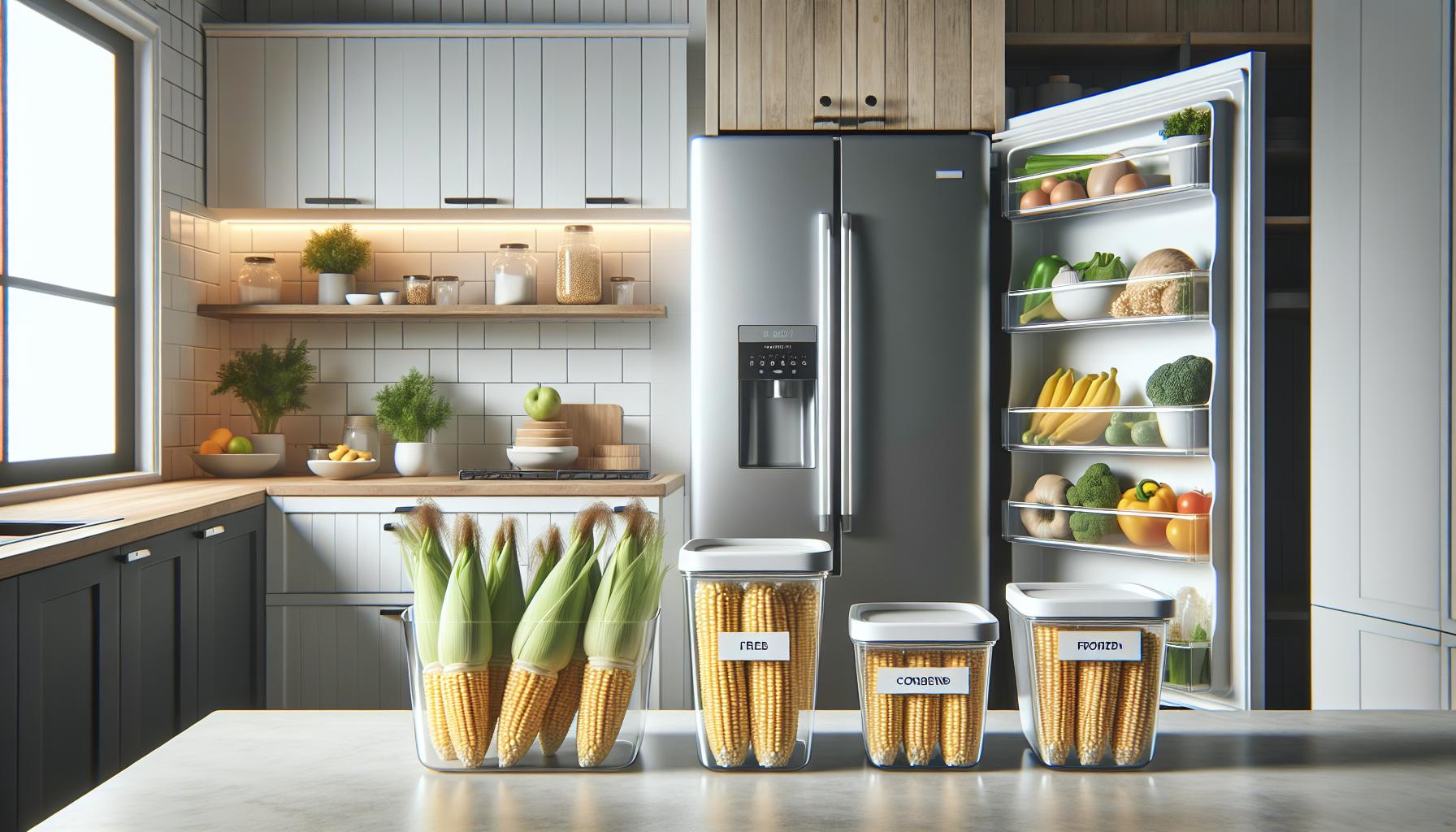
Signs That Fresh Corn has Gone Bad
Fresh corn can elevate any meal with its sweet and crisp goodness, but understanding signs of spoilage is crucial to ensure you enjoy it at its best. After being harvested, corn begins to lose its sweetness and texture due to sugar conversion to starch. Knowing what to watch for can help you determine when it’s time to let go of that ear of corn.
First, pay attention to the appearance and texture of the kernels. Fresh corn should have plump, moist kernels that are tightly packed together. If you notice shriveled or dry kernels, it’s a sure sign that the corn is past its prime. Discoloration can also indicate spoilage; kernels should maintain a vibrant yellow or white hue. Any browning or dark spots can mean that the corn is starting to degrade.
Another indicator is the husk itself. Fresh corn should feature green, vibrant husks, not brown or dried-out leaves. If the husk feels dry or appears damaged, it’s likely that the corn within has lost moisture and can be considered stale. Additionally, give it a sniff; fresh corn should have a sweet, pleasant smell. If you detect an off or sour odor, it’s best to avoid eating it.
Lastly, inspect the cob for mold or unusual slime. Mold can develop in a moist environment, and any evidence of this suggests that the corn should not be consumed. When in doubt, trust your senses, and remember that it’s always safer to err on the side of caution-discard any corn that shows multiple signs of spoilage to prevent foodborne illness.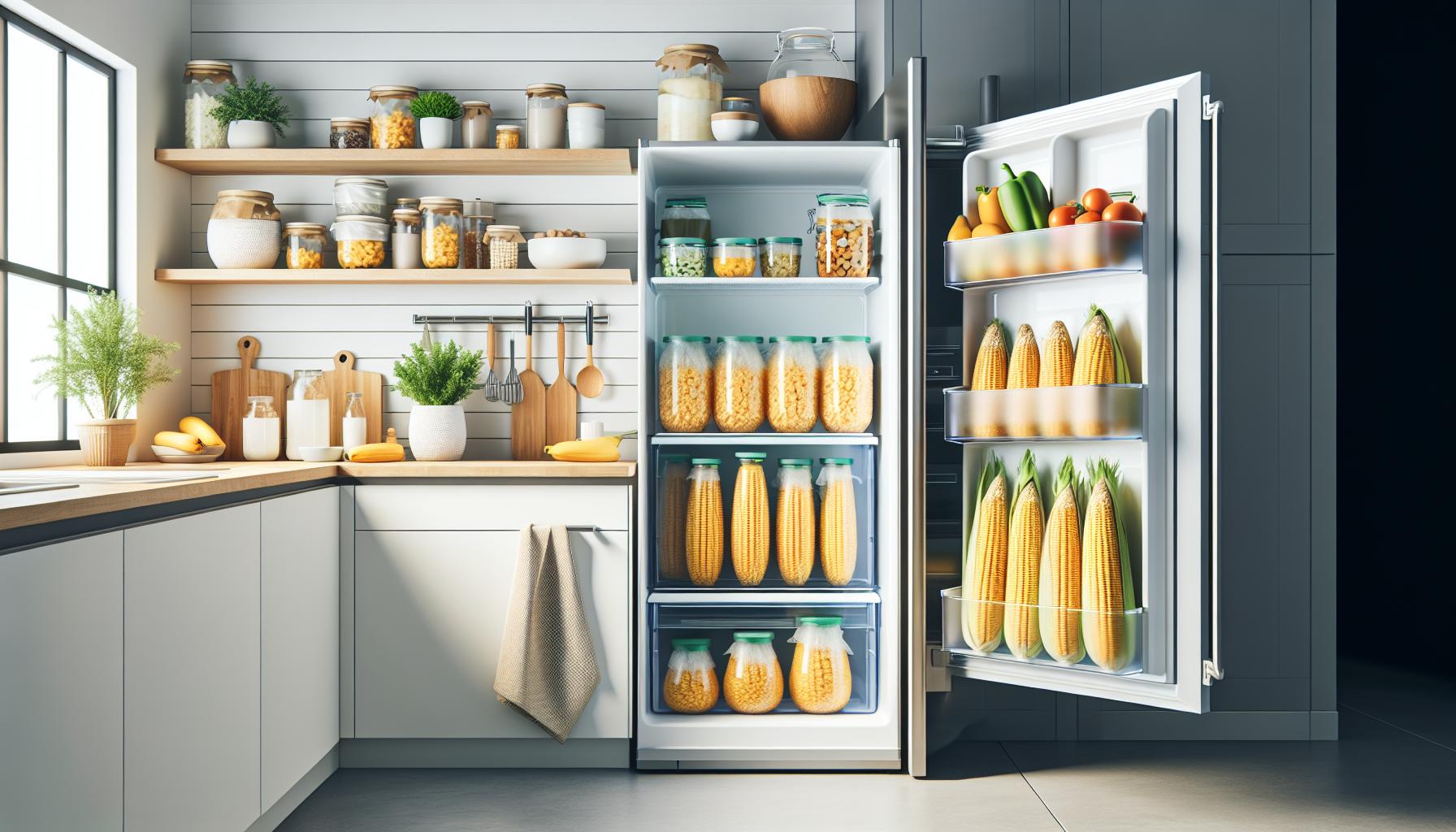
How to Keep Corn Crisp for Longer
Keeping corn crisp after harvesting is essential to enjoying its sweet and crunchy texture. When stored properly, fresh corn can last in the fridge for about 3 to 7 days. However, there are several strategies you can implement to extend its freshness even further and maintain that delightful crunch.
One of the best methods to preserve the crispness of corn is to keep it in its husk until you’re ready to use it. The husk acts as a protective barrier, helping to retain moisture and prevent the kernels from drying out. If you’ve already removed the husk, wrap the corn tightly in a damp paper towel and place it inside a perforated plastic bag. This allows for some air circulation while keeping the corn moist. Ensure that your refrigerator is set at a consistent temperature of around 32°F to 40°F (0°C to 4°C), as cooler temperatures can slow down the sugar-to-starch conversion that affects sweetness.
Additional Tips for Keeping Corn Crisp
To further enhance the storage life of corn, consider these additional tips:
- Store in the vegetable crisper: Place the corn in the crisper drawer of your fridge, which is typically designed for optimal humidity control.
- Avoid washing before storage: Moisture encourages spoilage, so it’s best to wash corn only before consumption.
- Use within a week: For the best sweetness and texture, aim to use your fresh corn within a week of purchase.
- Check regularly: Routinely inspect the corn for any signs of spoilage and remove any affected ears to prevent them from affecting others.
By following these practical storage guidelines, you can enjoy your corn at its freshest and crispiest, enhancing your culinary creations with its delightful flavor and texture.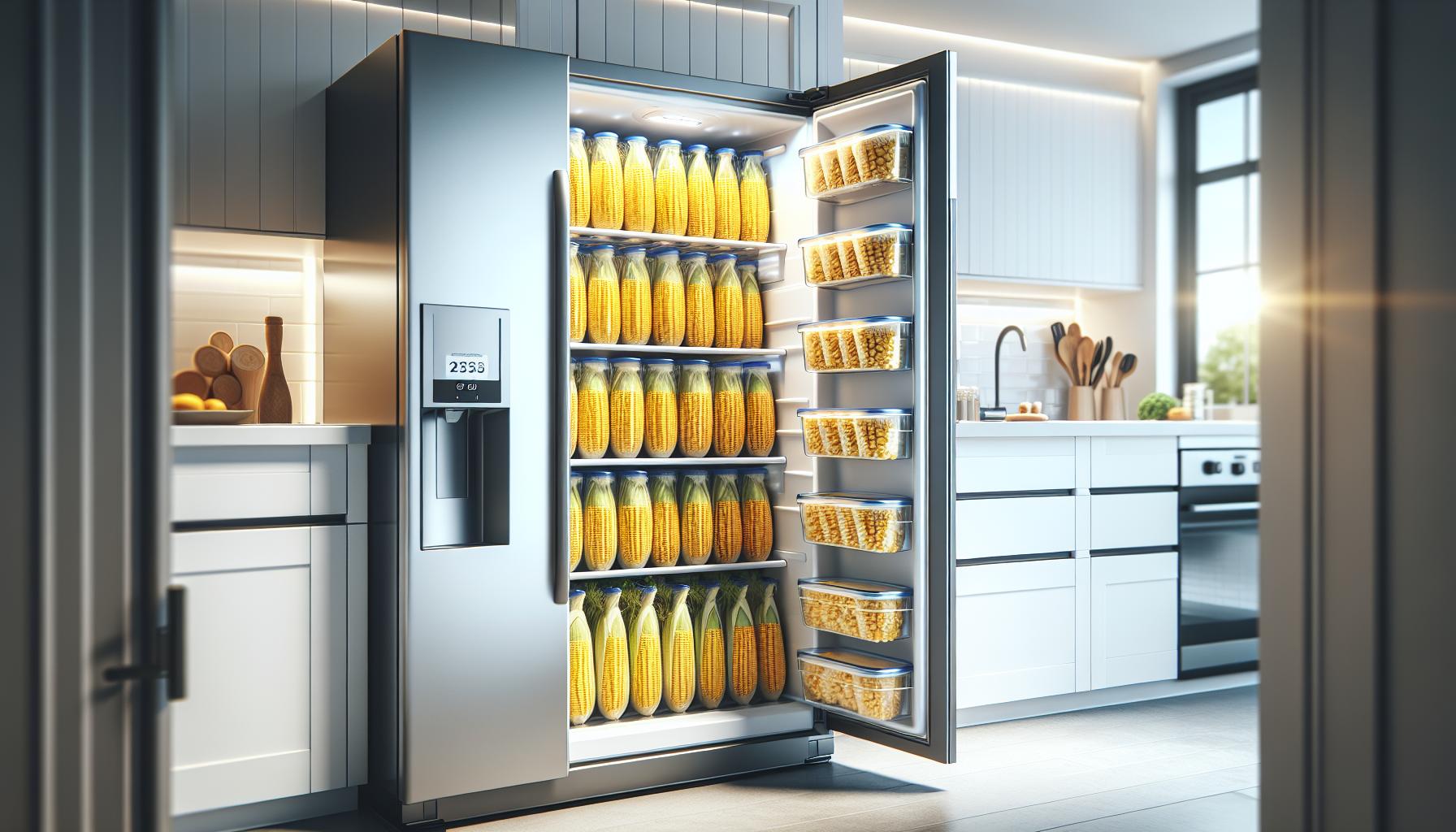
Freezing Fresh Corn: A Smart Option
One of the most effective ways to preserve the freshness and flavor of corn is by freezing it, allowing you to enjoy the taste of summer all year round. Freezing not only stops the aging process that occurs in fresh corn but also locks in its sweetness and vital nutrients. When done properly, frozen corn can maintain its quality for up to a year, making it a smart option for those who want to stock up when corn is in season.
To freeze corn effectively, start by selecting fresh, ripe ears. Ideally, corn should be frozen the same day it is harvested or purchased to retain its best flavor and texture. Begin by husking the corn and removing all silks. Next, blanch the ears in boiling water for about 4-6 minutes. This step is crucial; it halts enzyme actions that can lead to loss of flavor, color, and texture during freezing. Once blanched, immediately transfer the corn to an ice bath to stop the cooking process. After they have cooled, drain the ears thoroughly and dry them gently with a towel.
For storage, you can choose either to freeze the entire ear or cut the kernels off the cob. If you opt for cutting the kernels, use a sharp knife to slice downward, collecting the kernels in a bowl. Package the corn in airtight freezer bags, ensuring to squeeze out as much air as possible or use a vacuum sealer for best results. Label each bag with the date and the amount. It’s advisable to portion the packages for easy use later, as once thawed, corn should not be refrozen.
When you’re ready to use your frozen corn, it’s best to add it directly to your cooking without thawing, especially in recipes like soups and stir-fries. This method helps maintain the corn’s texture and prevents it from becoming mushy. With proper freezing techniques, you can enjoy fresh corn long after the harvest has ended, ensuring its sweet and crisp goodness is only a thaw away.
Cooking Techniques to Maximize Freshness
The way you prepare fresh corn can significantly impact its flavor and texture, allowing you to enjoy its natural sweetness to the fullest. One of the best techniques to maximize freshness is through quick cooking methods that highlight its natural flavors. Whether you choose to grill, steam, or microwave, these methods preserve the crispness and vibrant taste of the corn without overcooking it.
Grilling corn gives it a delightful smoky flavor and charred texture. For the best results, soak the husked corn in water for about 30 minutes before grilling. This helps prevent the kernels from drying out during cooking. Preheat the grill to medium heat, and place the corn directly on the grates. Grill each ear for 10-15 minutes, turning occasionally until all sides are slightly charred. This technique not only adds a savory kick but also enhances the corn’s sweetness.
Steaming corn is another excellent way to maintain its freshness. Use a steamer basket over boiling water for about 5-7 minutes, just until the kernels are tender yet still firm. Steaming helps to retain more nutrients compared to boiling, making it a healthier option. For added flavor, consider tossing freshly steamed corn with a bit of butter and a sprinkle of salt or herbs right before serving.
Microwaving is a quick and convenient method, especially for those who are pressed for time. To microwave corn on the cob, simply husk the corn and wrap it in a damp paper towel. Place it on a microwave-safe plate and cook on high for about 3-4 minutes. This rapid method preserves moisture and minimizes the risk of drying out the kernels, helping to keep the corn tender and juicy.
By employing these cooking techniques, you can create delicious dishes that showcase the natural goodness of fresh corn, ensuring every bite is a burst of summer sweetness.
Nutritional Benefits of Fresh Corn Storage
Fresh corn, a staple of summer, not only tantalizes the taste buds but also packs an impressive nutritional punch. Storing corn properly in the fridge can help maintain its essential vitamins and minerals, ensuring each bite is as nutritious as possible. Corn is rich in dietary fiber, which aids digestion, and contains a variety of vitamins such as B vitamins, vitamin C, and essential minerals like magnesium and potassium. These nutrients contribute to overall health, supporting functions ranging from energy metabolism to cardiovascular health.
To maximize these benefits, it’s crucial to store fresh corn correctly. Ideally, keep the husked ears unwashed and in a perforated plastic bag to allow for air circulation while retaining moisture. This method prevents dehydration, helping the corn stay crisp and delicious for up to five days. If the corn is still in its husk, it should be stored in the crisper drawer of the refrigerator-both practices help preserve its flavor and nutritional integrity.
Furthermore, it’s beneficial to consume fresh corn soon after purchasing, as the sugar content begins to convert into starch soon after harvest, which can diminish its sweetness and texture. When stored improperly, corn can lose nutrients and develop an undesirable taste. By adhering to these storage principles, you can enjoy the full nutritional benefits that fresh corn has to offer, while also enhancing your culinary creations with its vibrant flavor.
In summary, proper storage of fresh corn in the fridge not only extends its lifespan but also preserves the array of nutrients it offers, allowing you to enjoy its fresh taste and health benefits longer. Make it a habit to check for freshness regularly, and always aim for consumption within a week of purchase to get the most out of your corn.
Common Myths About Corn Storage Debunked
Misconceptions about food storage can lead to waste or spoilage, especially with something as delightful as fresh corn. One common myth is that fresh corn should always be washed before storing. In reality, washing corn before storage can introduce moisture that promotes mold growth. Instead, keep the husked corn unwashed and place it in a perforated plastic bag to maintain air circulation while preventing dehydration.
Another widespread belief is that removing the kernels from the cob extends freshness. However, once corn has been cut, its sugars start to convert to starch rapidly. This process can significantly diminish flavor and sweetness in just a few days. It’s best to keep corn intact until you’re ready to enjoy it; this way, the sugars remain locked in, and the taste will be much more satisfying.
People often think that refrigerating corn is the best way to store it indefinitely. While refrigeration does help preserve freshness, corn is best consumed within a week of purchase to ensure optimal taste and texture. After this period, the quality diminishes-the sweetness fades, and it can develop off-flavors.
Lastly, many assume that all varieties of corn can be stored the same way. Different types, such as sweet corn, require specific conditions. Sweet corn, for instance, should be left in the husk to retain its natural moisture. Understanding the storage requirements for different corn varieties ensures that you get the best possible flavor and texture.
By demystifying these myths, you can take informed steps to maximize the freshness and enjoyment of your corn, transforming a simple ear into a standout ingredient in your meals.
Best Practices for Buying Fresh Corn
When purchasing fresh corn, it’s crucial to choose the best quality to ensure optimal flavor and sweetness. One of the simplest yet most effective methods to determine the freshness of corn is to examine the husk. Look for ears that are tightly wrapped with bright green husks, as this indicates that the corn is not only fresh but also retains moisture. Avoid any corn with brown, dry, or peeling husks, which may suggest that the corn is past its prime.
Inspect the kernels for further assurance. Fresh corn should have plump, juicy kernels that are tightly packed together. Gently squeeze the ear; if it feels firm and the kernels exude a milky juice when pierced, it’s a sign that the corn is fresh. Conversely, if the kernels are shriveled or the juice is clear, it’s best to steer clear, as this indicates age and potential loss of flavor.
Buying in Season: Fresh corn is typically at its peak from mid-summer to early fall. Purchasing corn during this season not only guarantees better flavor but often also offers lower prices. Shopping at local farmers’ markets can yield even fresher produce as it’s often harvested the same day or just hours before sale. This ensures you are getting corn that has been minimally transported and handled, preserving its fresh taste and texture.
Storage and Transportation Tips
Once you’ve selected your corn, proper transportation and storage are key to maintaining its freshness. If possible, keep the corn in a cool environment, such as an air-conditioned car, during your trip home. Once you arrive, store the corn in the refrigerator as soon as possible. It’s recommended to leave the corn in its husk until ready for use, as this helps retain moisture and prevents the kernels from drying out. With these practices, you can enjoy delicious, sweet corn that elevates your meals to a whole new level.
How to Use Leftover Fresh Corn Creatively
Leftover fresh corn is a versatile ingredient that can breathe new life into your meals. Rather than letting it languish in the fridge, consider creative ways to repurpose it that enhance your culinary repertoire. One great option is to make a corn salad. Combine the kernels with chopped tomatoes, cucumbers, red onion, and a zesty lime dressing for a refreshing side dish. This not only utilizes the leftover corn but also provides a vibrant, healthy addition to your table.
Another delicious way to use up leftover corn is to incorporate it into soups and stews. Corn adds natural sweetness and texture, enriching a variety of dishes. Simply add it to a pot of vegetable or chicken soup toward the end of cooking to maintain its crunch. For a creamier option, blend some corn with broth, seasonings, and a splash of cream to create a flavorful corn chowder.
You can also elevate breakfast dishes with leftover corn. Stir it into scrambled eggs for a sweet and savory twist or fold it into corn fritters. These fritters can be pan-fried until they’re golden brown, offering a delightful crunch. Serve them with a dollop of Greek yogurt or your favorite salsa for a flavorful start to your day.
Lastly, think about incorporating corn into your baking. Cornmeal muffins or cornbread can be delicious vehicles for using up leftover corn. Simply mix the kernels into your batter for added texture and flavor. These ideas not only help you reduce food waste but also invite exciting flavors to your meals.
Understanding Corn Varieties and Their Storage Needs
Understanding the nuances of corn varieties is essential for maximizing their freshness and flavor after harvest. Fresh corn comes in several types, each with distinct characteristics and storage needs. The most common varieties include sweet corn, field corn, popcorn, and ornamental corn. Knowing these distinctions not only helps in selecting the right corn for your meals but also plays a critical role in storage and preservation.
Sweet corn is the most popular variety consumed by humans. It is harvested while immature and is high in sugar content, giving it that classic sweet taste. To ensure its sweetness remains intact, sweet corn should be refrigerated as soon as possible after purchase. Store in the husks, or if husked, place it in an airtight container. When stored properly, sweet corn can last in the fridge for about 3 to 5 days, ideal for enjoying its peak flavor.
Field corn, on the other hand, is primarily grown for animal feed and industrial products. As it is harvested at a later maturity stage, it has a lower sugar content and is typically used in processed foods rather than for direct consumption. Therefore, field corn does not require the same immediate refrigeration and can be stored in a cool, dry place for longer durations.
Popcorn kernels should be stored in an airtight container in a cool, dark place to maintain their moisture content and popping quality. Unlike sweet corn, popcorn does not require refrigeration and can last for years if stored correctly, maximizing its lifespan significantly.
In addition to understanding these varieties, keeping corn in optimal storage conditions is crucial. Always aim to handle corn gently, as bruising can accelerate spoilage. For leftover cooked corn, refrigerate within two hours of cooking and consume within 3 to 5 days. Following these guidelines will help maintain the deliciousness and texture of the corn, ensuring your culinary creations shine.
Frequently asked questions
Q: How can I tell if fresh corn has gone bad?
A: Fresh corn may have gone bad if the kernels have a dull appearance, the husk is dry or brown, or if there’s an off smell. Additionally, kernels should feel plump and firm. For more details, refer to the section on ‘Signs That Fresh Corn has Gone Bad’ in the article.
Q: What is the best way to store fresh corn to maximize its lifespan?
A: Store fresh corn in the fridge, ideally in a perforated plastic bag to maintain moisture while allowing airflow. Keeping it in the vegetable crisper drawer helps extend its shelf life, as covered in the ‘How Fresh Corn is Best Stored in the Fridge’ section.
Q: Can I cook fresh corn after it’s past its expiration date?
A: It is not advisable to cook or consume corn past its expiration date if it shows signs of spoilage. Always check for freshness indicators before cooking. For methods to maximize freshness, see ‘Cooking Techniques to Maximize Freshness’.
Q: How long can you freeze fresh corn for future use?
A: Fresh corn can be frozen for up to 12 months without losing significant quality. Blanching before freezing helps preserve its color and taste. More on this is discussed in ‘Freezing Fresh Corn: A Smart Option’.
Q: Should I wash fresh corn before storing it in the fridge?
A: It’s best to leave fresh corn unwashed until ready to use, as excess moisture can accelerate spoilage. For more on proper preparation, see ‘How Fresh Corn is Best Stored in the Fridge’.
Q: What varieties of corn have different storage needs?
A: Different corn varieties, such as sweet corn and field corn, may have varied storage requirements. Sweet corn should be consumed more quickly, while field corn can last longer. Learn more under ‘Understanding Corn Varieties and Their Storage Needs’.
Q: How do I keep cooked corn fresh in the fridge?
A: To keep cooked corn fresh, store it in an airtight container in the fridge. It should last for about 3-5 days. For storage and keeping tips, refer to ‘Best Practices for Buying Fresh Corn’ and other sections of the article.
Q: What are some creative ways to use leftover fresh corn?
A: Leftover fresh corn can be added to salads, soups, or salsas, or used in cornbread and fritters. For more ideas, check the section ‘How to Use Leftover Fresh Corn Creatively’.
To Conclude
To keep your fresh corn crisp and delicious, remember that it lasts 5 to 7 days in the fridge when stored properly. Always check for any signs of spoilage, and if you’re not planning to use it soon, consider freezing it for long-term storage. If you found this information helpful, dive deeper into our storage tips by reading “How to Freeze Corn: A Quick Guide” or explore our article on “Best Practices for Storing Vegetables.”
Don’t forget to sign up for our newsletter to stay updated with the latest food storage tips and recipes that maximize freshness! Remember, knowing how to handle your food not only enhances your meals but also ensures your safety. If you have any questions or additional tips to share, we’d love to hear from you in the comments below. Keep your kitchen thriving and join our community for more essential insights!

